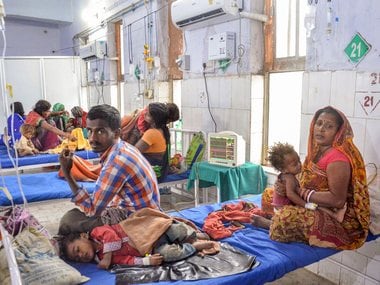Acute Encephalitis Syndrome (AES) is a crippling public health problem in India, particularly in the states of Bihar, Assam and Uttar Pradesh. It has become an annual event, mainly affecting children under the age of 15 years. The first major outbreak of the virus struck West Bengal in 1973, triggering around 700 cases and over 300 deaths. The Japanese Encephalitis virus (JEV) was identified as the cause. Between 1978 and 2007, over one lakh cases of AES, with a case fatality rate (CFR) of almost 33 percent, were reported from 13 different states. It was widely presumed that JE was the predominant causative agent in these outbreaks. [caption id=“attachment_6834151” align=“alignleft” width=“380”]
 Children suffering from Acute Encephalitis Syndrome (AES) being treated at a hospital in Muzaffarpur on Monday. PTI[/caption] Between 1 January, 2008 and 27 August, 2014, a total of 44,097 cases and 5,728 deaths due to AES were reported in India. This figure represents a significant increase in the recent annual number of reported cases even as the CFR dropped to around 13 percent. An average of 8,139 cases per year has been reported for 2011-13, an increase of 220 percent over the period 2003-2007. These numbers could be an underestimate. Government statistics do not generally include cases that never make it to hospital. AES outbreaks predominantly affect rural communities with poor access to healthcare and, hence, are less likely to be notified as AES cases. Dozens of children have died recently in Bihar’s Muzaffarpur due to AES. The state government is confused over the real “cause”. The fact remains that in many cases, the causative agent remains elusive. To the best of my understanding, the cause of AES is a “mixed pot”. Medical textbooks describe more than 100 causes of AES. The definition of AES, as provided by the World Health Organisation (WHO) is truly encompassing and includes literally every agent which may cause brain symptoms with a fever of fewer than two weeks. It may be viruses like JEV (most commonly blamed) or others like dengue virus, bacteria like leptospira and scrub typhus, parasites like malaria and fungus like cryptococcus. Many of the causative agents like dengue virus and scrub typhus are not primarily causing diseases of the brain, but brain symptoms may occur as a complication of the disease. AES, the mystery fever, has also been linked to a toxin associated with consumption of the lychee fruit on the background of malnourishment and heatstroke. There are reports citing hypoglycaemia (low sugar level in blood) as a cause of death in children following litchi consumption. Convulsions, high fever and insufficient blood sugar are anyway symptoms of AES. Despite efforts of the Government of India, the burden and mortality of AES cases have not decreased, and definitive causative agents are yet to be pinned down. Identification of a specific agent may be important for patient management at least in treatable conditions like bacteria, leptospira, scrub typhus, etc.
Despite efforts of the Government of India, the burden and mortality of AES cases have not decreased, and definitive causative agents are yet to be pinned down.
Advertisement
End of Article


)

)
)
)
)
)
)
)
)



